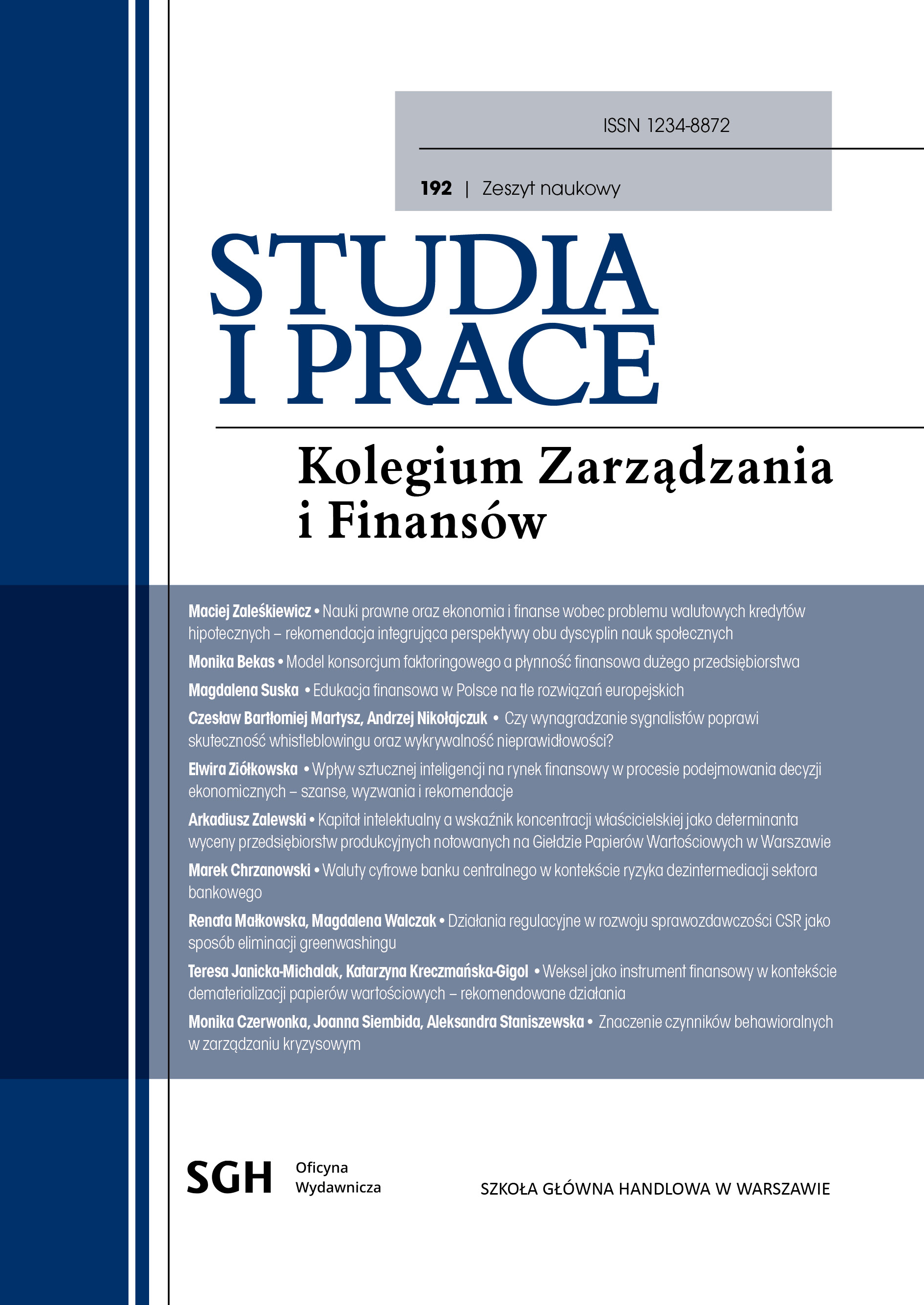Central Bank Digital Currencies (CBDC) in the context of the disintermediation risk of the banking sector
DOI:
https://doi.org/10.33119/SIP.2023.192.7Keywords:
CBDC, disintermediation of banks, monetary policyAbstract
The aim of the article is to verify the validity of the thesis on the disintermediation of banks as a consequence of introducing the Central Bank Digital Currency (CBDC) and to determine how the impact of the CBDC on bank disintermediation can be programmed. The analysis indicates that regardless of the adopted research concept and the shape of the financial sector, the risk of structural bank disintermediation is always present. Previous studies in this area have often provided different recommendations and require further exploration or cautious interpretation. At the same time, the spectre of disintermediation can be mitigated by using quantitative instruments that regulate the interest rates on the CBDC, imposing transaction size limits, and setting limits on the amount of funds held by individual users of digital currencies. From the perspective of the objectives set for the CBDC, adjustments in monetary policy such as replenishing lost bank deposits with wholesale funding provided by the central bank (e.g. through programmes like TLTRO) may be more appropriate.
Downloads
References
1. Chrzanowski, M. (2021). Fintech jako katalizator zmian na rynku usług finansowych oraz ich wpływ na poziom kosztów transakcyjnych w gospodarce. Warszawa: Oficyna Wydawnicza SGH.
2. Knakiewicz, W. Z., Jurek, M., Marszałek, P. (2011). Teorie pieniądza i ich wykorzystanie: od pieniądza kruszcowego do fiducjarnego. Poznań: Wydawnictwo Uniwersytetu Ekonomicznego w Poznaniu.
3. NBP (2021). Pieniądz cyfrowy banku centralnego. Warszawa: Narodowy Bank Polski.
4. Szegö, G. P., Shell, K. (1972). Mathematical Methods in Investment and Finance. Amsterdam: North-Holland Publishing Company.
Artykuły prasowe i okolicznościowe
1. Andolfatto, D. (2020). Assessing the Impact of Central Bank Digital Currency on Private Banks, The Economic Journal, 131 (634), s. 525–540. DOI: 10.1093/ej/ueaa073.
2. Assenmacher, K., Berentsen, A., Brand, C., Lamersdorf, N. (2021). A Unified Framework for CBDC Design: Remuneration, Collateral Haircuts and Quantity Constraints, EBC Working Paper Series, 2578. DOI: 10.2139/ssrn.3896787.
3. Baeriswyl, R., Reynard, S., Swoboda, A. (2022). Would a Retail CBDC Achieve Its Intended Purpose?, SUERF Policy Brief, 321.
4. Bech, M. L., Hancock, J., Rice, T., Wadsworth, A. (2020). On the Future of Securities Settlement, BIS Quarterly Review, March.
5. Bindseil, U. (2020). Tiered CBDC and the Financial System, EBC Working Paper Series, 2351. DOI: 10.2139/ssrn.3513422.
6. Bordo, M. D. (2021). Central Bank Digital Currency in Historical Perspective: Another Crossroad in Monetary History, NBER Working Paper Series, 29171. DOI: 10.3386/w29171.
7. Burlon, L., Montes-Galdón, C., Muñoz, M., Smets, F. (2022). The Optimal Quantity of CBDC
in a Bank-Based Economy, EBC Working Paper Series, 2689. DOI: 10.2139/ssrn.4175853.
8. Chiu, J., Davoodalhosseini, M., Jiang, J. H., Zhu, L. (2022). Bank Market Power and Central Bank Digital Currency: Theory and Quantitative Assessment, Journal of Political Economy, 131 (5), s. 1213–1248. DOI: 10.1086/722517.
9. Diamond, P. A. (1965). National Debt in a Neoclassical Growth Model, American Economic Review, 55 (5), s. 1126–1150.
10. Fegatelli, P. (2021a). The One Trillion Euro Digital Currency: How to Issue a Digital Euro without Threatening Monetary Policy Transmission and Financial Stability?, BCL Working Papers, 155.
11. Fegatelli, P. (2021b). The One Trilion Euro CBDC: Issuing Digital Euro without Disrupting the Bank Lending Channel, SUERF Policy Briefs, 209.
12. Garratt, R., Yu, J., Zhu, H. (2022). How Central Bank Digital Currency Design Choices Impact Monetary Policy Pass-Through and Market Composition, Working Paper. DOI:10.2139/ ssrn.4004341.
13. IMF (2018). Casting Light on Central Bank Digital Currency, IMF Staff Discussion Note, 18/08.
14. Infante, S., Kim, K., Orlik, A., Silva, A. F., Tetlow, R. J. (2022). The Macroeconomic Implications of CBDC: A Review of the Literature, Finance and Economics Discussion Series, 076. DOI: 10.17016/feds.2022.076.
15. Keister, T., Sanches, D. R. (2022). Should Central Banks Issue Digital Currency?, The Review of Economic Studies, 90 (1), s. 404–431. DOI: 10.1093/restud/rdac017.
16. Klein, M. L. (1971). A Theory of the Banking Firm, Journal of Money, Credit and Banking, 3 (2), s. 205–218. DOI: 10.2307/1991279.
17. Kosse, A., Mattei, I. (2022). Gaining Momentum – Results of the 2021 BIS Survey on Central Bank Digital Currencies, BIS Papers, 125.
18. Lagos, R., Wright, R. (2005). A Unified Framework for Monetary Theory and Policy Analysis, Journal of Political Economy, 113 (3), s. 463–484. DOI: 10.1086/429804.
19. Marszałek, P. (2016). Disintermediation of Banks – Causes and Consequences, Prace Naukowe Uniwersytetu Ekonomicznego We Wrocławiu, 451, s. 256–267. DOI:10.15611/pn.2016.451.21.
20. Whited, T. M., Wu, Y., Xiao, K. (2022). Central Bank Digital Currency and Banks, Working Paper. DOI: 10.2139/ssrn.4112644.
21. Williamson, S. D. (2021). Central Bank Digital Currency and Flight to Safety, Journal of Economic Dynamics and Control, 142. DOI: 10.1016/j.jedc.2021.104146.
Materiały internetowe
1. Deloitte (2020). Are Central Bank Currencies (CBDCs) the Money of Tomorrow?, https://www2.deloitte.com/content/dam/Deloitte/lu/Documents/financial-services/Banking/ lu-are-centralbank-digital-currencies.pdf (dostęp: 30.05.2023).
2. Nelson, J. F. (1968). Disintermediation, https://fraser.stlouisfed.org/title/economic-quarterlyfederal-reserve-bank-richmond-960/april-1968-37749/new-unified-budget-387148 (dostęp:30.05.2023).
3. Piazzesi, M., Schneider, M. (2022). Credit Lines, Bank Deposits or CBDC? Competition and Efficiency in Modern Payment Systems, https://web.stanford.edu/~piazzesi/CBDC.pdf (dostęp:30.05.2023).









